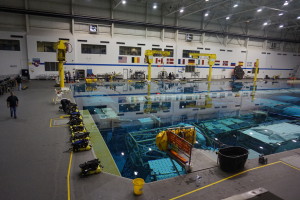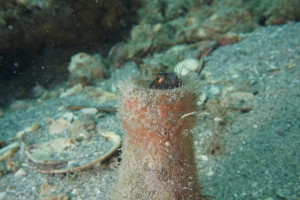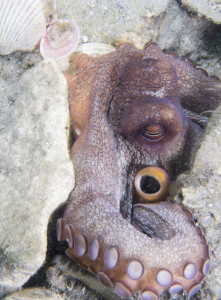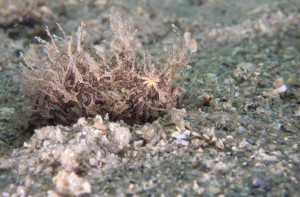This past week was a hectic one – after flying back home from DAN, I had 3-4 days to prepare and pack for a month of adventures. I spent Sunday resting and mentally preparing myself for the month ahead.
Monday I woke up incredibly early to go to NASA’s Sony Carter Training Facility (also known as the Neutral Buoyancy Lab). The OWUSS regional coordinator for the Gulf Coast, Bob Straight, referred me to Greg Sims, a contact at the NBL, and I decided to get in touch with Greg several weeks prior. Nothing ventured, nothing gained! Greg had invited me out to tour the lab so Monday was that day and I was excited to get to see the training that goes on at the NBL. I arrived at the facility early in the morning, before the divers had prepared for their training dive of the day. I was greeted at the front desk by Greg, and after introductions, he quickly moved me from the check-in area to behind the scenes. Walking out onto the pool deck took my breath away! The pool is massive, stretching down the training center, with a complete mock-up of a space station contained in its 40’ deep waters. The surface of the pool is completely glasslike, allowing you to peer down into the blue waters at the space station, an incredible sight to look at and take in.

Greg then moved me up to the control center, a deck overlooking the pool, where the pre-dive briefing was to be held. Greg all the while was telling me information about the pool – how NASA acquired the facility, its various uses, how it has transformed over the past 25 years. All the while the divers, astronauts in training, and various staff members were gathering for the dive briefing. After a run down of the activities that were to be practiced during the training dive, everyone gave the ok to dive and the training was on! The astronauts went down to get into their suits and the support divers started getting ready for their respective positions. Greg and I watched the astronauts suit up and get lowered by platform into to the pool, which was a sight to see.

He continued to explain what was going on as the divers checked for buoyancy with the astronaut, and told me what drills would be practiced for the day. After a few minutes of watching, we moved on to look at more of the facility. He showed me the panels that control the video and communication throughout the dive, the video screens that monitor the space arm under water, and the umbilical cords that supply air to the astronauts. We walked further back towards the far end of the facility, where there were various mock-ups used for outside training (i.e., rescue procedures for offshore oil drilling platforms or testing on undersea pipelines).
Greg then escorted me down to the compressor station, gear repair room, and air banks outside – all of which were in immaculate and pristine condition, despite the huge flow of tanks to be filled and gear to be repaired everyday. We then stopped briefly by the lab that hand constructs the astronauts’ suits and he showed me NASA’s training ROV that sometimes gets used for drills in the pool. We then swung over to the hyperbaric chamber that is always prepped to go when training drills are underway and the mock-up of the Orion, which they use in the pool to practice recovery strategies. I was full of wonder and awe during the entire tour. It was such an honor to be allowed the intimate inside look at the training facility and I learned about the ways diving is so pertinent to the most opposite of activities.

After two more days of packing and preparing, I found myself with my suitcases full and ready for a month of adventure ahead. My first stop was Fort Lauderdale to attend a 3.5 day photography course with one of my sponsors, Reef Photo and Video. This course proved itself to be invaluable to me, especially right at the beginning of my year. I have no underwater photography experience but have been generously loaned a Sony A5000, Nauticam housing, and Inon strobes by RPV, so the course was crucial in teaching me to use what I was loaned for the year. At first, I was pretty intimidated by the other “students” in the group – everyone seemed to have a fairly solid background in underwater photography and had these gigantic set ups (some the size and weight of a small child). Did I get myself in over my head? But after introductions, I realized that although my experience level was definitely the least, everyone was incredibly welcoming and fun. We spent three days in a mix of classroom discussions and learning sessions with long dives off Blue Heron Bridge. This site was perfect for photography – shallow, easy diving with plenty of subjects to be found. The first dive felt completely overwhelming for me as I literally had no idea what I was doing with any of my gear and was terrified my housing was going to flood. But success was to be had! I managed to capture some solid images, especially for my first go at underwater photography (and didn’t flood my nice new camera!).


It only got better and easier from that first dive – after comprehensive discussions led by the Americas Nauticam Rep, Chris Parsons, I gained a much better understanding of what techniques and settings to try while diving and continued to get some decent (or at least decent in my opinion) photos throughout the rest of the course. I left with a feeling of still having much to learn and practice but with a firm grasp of basic techniques to apply to my photography on each dive. I was incredibly grateful to the team at RPV and Chris, who prepared me to face the year feeling capable and confident of capturing good images of my adventures to come.


During my no-fly day in Fort Lauderdale, the 2014 NA Rolex Scholar, Ana, and I visited one of our sponsors, Pascal Lecocq and his wife Francoise at their home nearby. Pascal gave us a look at his studio and some of his new and old pieces, as well as telling us about his creative process and his history as an artist. I spent the rest of the day packing and preparing for my next destination, the Dominican Republic.
And that’s where I find myself now, spending 12 days with Dr. Charlie Beeker and his team from Indiana University in the Dominican Republic, learning about Charlie’s efforts to turn the country’s historic shipwrecks into Living Museums, preserved for generations of divers to come.